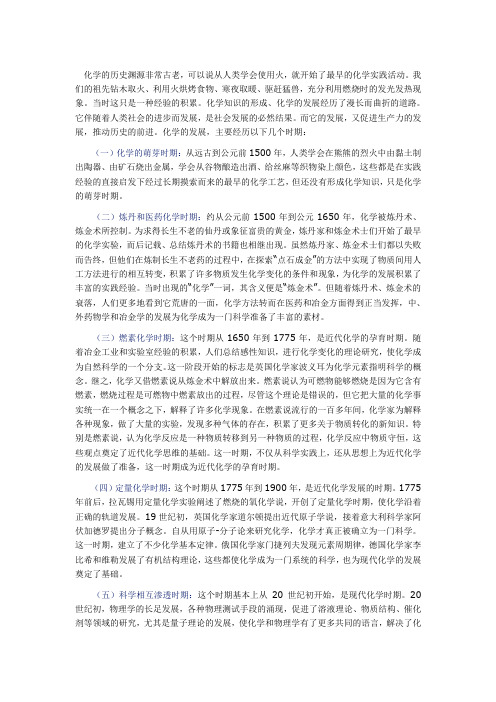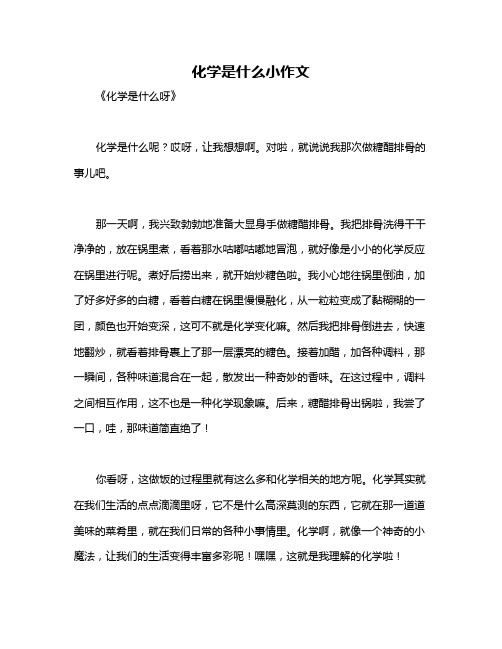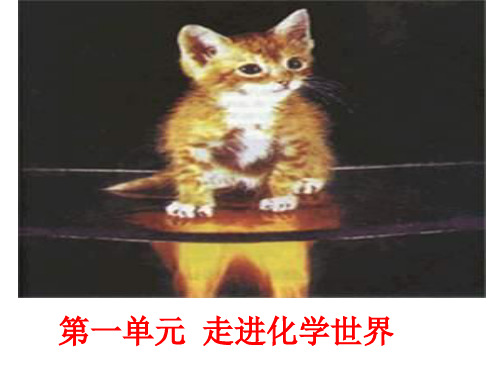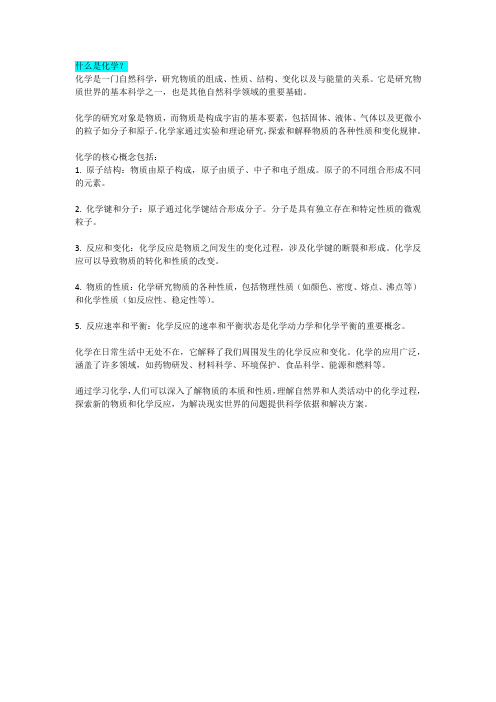什么是化学
什么是无机化学

什么是无机化学
无机化学是一门研究无机物质的组成、结构、性质和反应规律的自然科学。
它与有机化学相辅相成,共同构成了化学这门学科。
无机化学的研究对象包括无机化合物、矿物、岩石和生物体中的无机成分。
在科学研究和生产实践中,无机化学发挥着重要作用,它不仅为我们提供了丰富的化学知识,还为新材料、新药物、新能源等领域的研究提供了理论基础。
无机化学的研究内容广泛,包括以下几个方面:
1.元素周期表和元素周期律:元素周期表是将元素按照一定的规律排列,反映元素之间内在联系的表格。
元素周期律则是对元素周期表中元素性质的规律性总结,它揭示了元素原子结构的规律性变化。
2.化合物:化合物是由两种或两种以上元素组成的纯净物。
无机化学主要研究金属和非金属元素的化合物,如氧化物、酸、碱、盐等。
3.矿物和岩石:矿物是自然界中存在的无机物质,具有一定的化学成分和物理性质。
岩石是由一种或多种矿物组成的自然物体。
无机化学研究矿物和岩石的组成、结构和性质,以及它们的形成和变化规律。
4.生物体中的无机成分:生物体中含有多种无机物质,如钙、磷、铁等。
无机化学研究这些无机成分在生物体中的作用和代谢规律,对于了解生命现象和防治疾病具有重要意义。
5.应用无机化学:无机化学在许多领域都有广泛的应用,如新材
料研究、环境保护、能源开发、药物研制等。
研究无机化学的应用,可以为我国的科技创新和经济发展提供支持。
总之,无机化学作为化学的一个重要分支,研究内容丰富,应用领域广泛。
它为人类认识自然、利用资源和创造新物质提供了宝贵的知识和技术支持。
什么是化学英语作文

什么是化学英语作文Chemistry is a fascinating field of study that explores the fundamental nature of matter and the transformations it undergoes. At the heart of this scientific discipline lies a unique language, often referred to as "Chemical English," which serves as a vital means of communication and understanding within the scientific community. This specialized language encompasses a vast array of terminology, symbols, and conventions that enable chemists to precisely convey their ideas, findings, and theories.One of the defining characteristics of Chemical English is its extensive use of specialized vocabulary. Chemists employ a wide range of terms, such as "atoms," "molecules," "bonds," "reactions," and "compounds," to describe the various entities and processes they study. These terms often have precise definitions and carry specific meanings that may differ from their everyday usage in the English language. For example, the term "element" in chemistry refers to a fundamental substance that cannot be broken down into simpler components, whereas in common speech, it may have a more general connotation.In addition to specialized vocabulary, Chemical English also utilizes a system of symbols and abbreviations to represent the various components and reactions involved in chemical processes. These symbols, such as the periodic table of elements, chemical formulas, and reaction equations, serve as a concise and efficient means of conveying complex information. By using these standardized representations, chemists can communicate their ideas and findings with clarity and precision, minimizing the potential for ambiguity or misunderstanding.Another key aspect of Chemical English is its emphasis on precision and accuracy. Chemists must be meticulous in their use of language, as even the slightest variation in terminology or notation can have significant implications for the interpretation of their work. This attention to detail is particularly important when communicating experimental procedures, data analysis, and theoretical concepts, as any ambiguity or inconsistency could lead to errors or misunderstandings.The importance of Chemical English extends beyond the confines of the laboratory or classroom. As a global scientific community, chemists rely on this specialized language to collaborate, share their research, and engage in discussions with colleagues from around the world. The ability to effectively communicate in Chemical English isessential for presenting at conferences, publishing in scientific journals, and participating in international research projects.Furthermore, the mastery of Chemical English is crucial for the dissemination of scientific knowledge to the general public. Chemists must be able to translate their complex findings into more accessible language, enabling non-specialists to understand the significance and implications of their work. This process of scientific communication requires a deep understanding of both the technical aspects of chemistry and the nuances of the English language.In conclusion, Chemical English is a vital component of the scientific field of chemistry. It serves as a specialized language that enables chemists to precisely convey their ideas, findings, and theories, both within the scientific community and to the broader public. By mastering the unique vocabulary, symbols, and conventions of Chemical English, chemists can effectively communicate their research, collaborate with colleagues, and contribute to the advancement of scientific knowledge.。
化学的重要性是什么

化学的重要性是什么引言概述化学作为自然科学的一个重要分支,研究物质的性质、组成、结构和变化规律,对于人类社会的发展和生存起着至关重要的作用。
化学的重要性体现在各个方面,包括生活中的应用、科学研究、工业生产以及环境保护等。
本文将通过五个大点来详细阐述化学的重要性,并对每个大点进行分析和讨论。
正文内容1.支撑生命存在与发展1.1元素周期表:化学研究的基础1.2生物有机化学:生命体的基础单位1.3食物的制备与营养成分:人类健康的关键1.4药物的研发与治疗:医学的支柱1.5基因的结构与功能研究:遗传与进化的解释2.探索物质的组成和性质2.1分析化学:揭示物质内部的奥秘2.2物质结构研究:解释物质性质与反应2.3化学反应研究:揭示事物变化的规律2.4材料科学与工程:创造新材料与开发新技术2.5能源研究与利用:推动清洁能源发展3.促进工业与生产的发展3.1催化剂的研发与应用:提高化学反应效率3.2高分子化学:塑料、橡胶等的生产与应用3.3经济合成与流程优化:降低生产成本3.4环境污染治理与废物处理:可持续发展的重要保障3.5化工产品的开发与创新:满足社会需求和经济增长4.推动环境保护与可持续发展4.1环境监测与评估:了解环境污染与变化4.2环境修复与治理:防止与修复环境污染4.3可持续能源与资源利用:减少对自然资源的依赖4.4农药与化肥的研发与应用:提高农业生产效率与质量4.5环境教育与科普:提高公众对环境问题的认识5.促进科学与技术的进步5.1前沿研究与创新:突破性科学成果的推动5.2新材料的开发与应用:创造新的科技产品5.3生物技术与生物医药:解决人类健康与生存问题5.4化学工程与制药工程:工艺流程优化与设备改进5.5标准制定与法规管理:规范化与监管科学与技术的应用总结化学作为一门科学,对于人类社会的发展和生存具有重要的作用。
通过探索物质的组成与性质,化学帮助人们理解事物的本质和相互关系,并为新材料的开发和制备提供基础。
100个化学疑难问题

100个化学疑难问题1. 什么是化学?2. 什么是化学反应?3. 什么是原子?4. 原子是如何组成分子的?5. 什么是元素?6. 元素周期表是什么?7. 元素周期表中的“周期”和“族”有什么意义?8. 什么是离子?9. 离子是如何形成的?10. 什么是原子键和分子键?11. 什么是化学键能?12. 什么是物质的三态?13. 什么是离解?14. 什么是酸碱中和反应?15. 什么是氧化还原反应?16. 什么是电解质和非电解质?17. 什么是溶液的浓度?18. 什么是中性溶液、酸性溶液和碱性溶液?19. 什么是溶解度和溶解平衡?20. 什么是氧化剂和还原剂?21. 什么是化学平衡?22. 什么是动态平衡?23. 什么是浓度平衡常数?24. 什么是气体的化学反应?25. 什么是气体的压强和体积?26. 什么是理想气体状态方程?27. 什么是电化学反应?28. 什么是电解过程?29. 什么是腐蚀反应?30. 什么是络合物和配位化合物?31. 什么是化学平衡常数?32. 什么是光化学反应?33. 什么是光谱学?34. 什么是原子吸收光谱分析?35. 什么是质谱分析?36. 什么是核磁共振谱分析?37. 什么是红外光谱分析?38. 什么是紫外-可见光谱分析?39. 什么是质子转移质谱分析?40. 为什么一些物质会发生放光?41. 什么是化学动力学?42. 什么是酶催化?43. 什么是催化剂?44. 什么是表面活性剂?45. 什么是胶体溶液?46. 什么是聚合物?47. 什么是高分子化合物?48. 什么是单质?49. 什么是同素异形体?50. 什么是有机化学?51. 什么是碳链?52. 什么是化学键的极性?53. 什么是酮和醇?54. 什么是醛和醇?55. 什么是酸和碱?56. 什么是酯?57. 什么是酚?58. 什么是卤代烷烃?59. 什么是脂肪族化合物?60. 什么是芳香族化合物?61. 什么是饱和和不饱和化合物?62. 什么是脂肪酸?63. 什么是胺?64. 什么是氨基酸?65. 什么是蛋白质?66. 什么是核酸?67. 什么是多糖?68. 什么是天然合成和人工合成?69. 什么是化学反应速率?70. 什么是反应活性?71. 什么是反应中间体?72. 什么是反应速率常数?73. 什么是表观反应级数?74. 什么是动力学控制和平衡控制?75. 为什么有些反应速率很慢?76. 什么是催化反应?77. 什么是酶催化反应?78. 为什么反应速率会随温度变化?79. 什么是化学平衡的前向反应和逆向反应?80. 什么是平衡常数表达式?81. 什么是平衡浓度?82. 什么是平衡常数和反应浓度之间的关系?83. 什么是Le Chatelier原理?84. 什么是局部平衡和整体平衡?85. 什么是酸碱指示剂?86. 什么是强酸和弱酸?87. 什么是强碱和弱碱?88. 什么是氧化数?89. 什么是电极电势?90. 什么是标准电极电势?91. 什么是红氧电位和种子电位?92. 什么是电池?93. 什么是电解池?94. 什么是阴阳极反应?95. 什么是电化学计量?96. 什么是电解和电解质?97. 什么是迁移率和电导率?98. 什么是Faraday定律?99. 什么是电解质和非电解质的区别?100. 什么是欧姆定律?。
什么是化学

什么是化学
化学是研究物质的性质、组成、结构、变化和反应的科学领域。
它涉及了原子和分子的构建、元素之间的组合,以及它们之间如何在不同条件下进行各种变化和相互作用。
化学是自然科学的一个分支,也是一门实验科学,广泛应用于生物学、地球科学、物理学、医学和工程等领域。
以下是化学研究的一些主要方面:
1. 物质的组成:化学研究了物质的组成,包括元素和化合物。
元素是由相同类型的原子组成的,而化合物是由不同元素的原子以特定比例结合而成的。
2. 分子和原子结构:化学研究了分子和原子的结构,以及它们之间的相互作用。
原子是物质的基本构建单元,而分子是由原子以一定方式组合而成的。
3. 反应和变化:化学研究了物质在不同条件下的变化和反应。
这包括化学反应的类型、反应速率、平衡等方面的研究。
4. 能量变化:化学研究了化学反应中涉及的能量变化,包括吸热反应和放热反应等。
5. 周期表:化学通过周期表系统地组织了所有已知的元素,这是一个基于元素的原子结构和性质的分类表。
6. 分析和合成:化学通过分析物质的成分和结构,以及合成新的物质,为许多实际应用提供了基础,如药物、材料、化肥等。
化学的研究不仅有助于理解自然界的运作,还为科技创新和解决现实问题提供了关键的基础。
什么是化学?

什么是化学?
什么是化学?
一、关于化学基本概念
化学概念是对一类化学是事物的概括,是反应物质在化学运动中特有属性的一种思维形式。
它反映着一类事物的共同特征。
如“分子”,属于化学学科的一个基本概念,此概念反映了所有分子的共同特性----一种保持物质化学性质的微粒。
和其他学科的概念一样,完整的化学概念通常由概念的名称、概念的例证、概念的内涵和外延等三个部分组成。
(1)概念的名称——用以表达概念的一种符号。
如“分子”这一“符号”就是概念的名称;
(2)概念的例证——指的是概念所指的同类事物。
如水分子(h2o)、氧分子(o2)等都是分子的一个例证,被称之为“正例”(属于“分子”这一类);而氢原子(h)、氧原子(o)等不属于分子,则被称为“反例”。
(3)概念的内涵和外延。
内涵——指同类事物的共同本质属性;外延——指该类事物所涉及的范围。
它们之间的关系是:概念内涵的属性越多越具体,则概念的外延就越小。
以“分子”的概念为例三者之间的关系为:
分子是保持物质的化学性质的一种微粒,如水分子(h2o)、氧分子(o2)。
加粗、下划线部分为概念的名称;加粗部分为概念的内涵,。
从什么时候开始有化学

化学的历史渊源非常古老,可以说从人类学会使用火,就开始了最早的化学实践活动。
我们的祖先钻木取火、利用火烘烤食物、寒夜取暖、驱赶猛兽,充分利用燃烧时的发光发热现象。
当时这只是一种经验的积累。
化学知识的形成、化学的发展经历了漫长而曲折的道路。
它伴随着人类社会的进步而发展,是社会发展的必然结果。
而它的发展,又促进生产力的发展,推动历史的前进。
化学的发展,主要经历以下几个时期:(一)化学的萌芽时期:从远古到公元前1500年,人类学会在熊熊的烈火中由黏土制出陶器、由矿石烧出金属,学会从谷物酿造出酒、给丝麻等织物染上颜色,这些都是在实践经验的直接启发下经过长期摸索而来的最早的化学工艺,但还没有形成化学知识,只是化学的萌芽时期。
(二)炼丹和医药化学时期:约从公元前1500年到公元1650年,化学被炼丹术、炼金术所控制。
为求得长生不老的仙丹或象征富贵的黄金,炼丹家和炼金术士们开始了最早的化学实验,而后记载、总结炼丹术的书籍也相继出现。
虽然炼丹家、炼金术士们都以失败而告终,但他们在炼制长生不老药的过程中,在探索“点石成金”的方法中实现了物质间用人工方法进行的相互转变,积累了许多物质发生化学变化的条件和现象,为化学的发展积累了丰富的实践经验。
当时出现的“化学”一词,其含义便是“炼金术”。
但随着炼丹术、炼金术的衰落,人们更多地看到它荒唐的一面,化学方法转而在医药和冶金方面得到正当发挥,中、外药物学和冶金学的发展为化学成为一门科学准备了丰富的素材。
(三)燃素化学时期:这个时期从1650年到1775年,是近代化学的孕育时期。
随着冶金工业和实验室经验的积累,人们总结感性知识,进行化学变化的理论研究,使化学成为自然科学的一个分支。
这一阶段开始的标志是英国化学家波义耳为化学元素指明科学的概念。
继之,化学又借燃素说从炼金术中解放出来。
燃素说认为可燃物能够燃烧是因为它含有燃素,燃烧过程是可燃物中燃素放出的过程,尽管这个理论是错误的,但它把大量的化学事实统一在一个概念之下,解释了许多化学现象。
苏教版九年级下册化学书电子书

苏教版九年级下册化学书电子书第1章开启化学之门第一节化学给我们带来什么古代化学工艺;什么是化学;认识煤气炉具;铁锅烧菜好;吸烟有害;碳酸氢铵分解;碳酸氢铵贮存;淡水资源;铁生锈的条件;白色污染;高锰酸钾溶液区分二氧化碳与二氧化硫;大气污染;全球气候变暖;臭氧空洞;酸雨;合成材料(有机玻璃);纳米材料第二节化学研究些什么蜡烛燃烧;物理变化;化学变化;物理性质;化学性质;光合作用;金刚石;氯化氢与氨气反应;碘化钾与硝酸银溶液反应;化学变化与现象;化学变化与能量;物质的组成与构成;石英晶体;石墨;煤与石油;结晶牛胰岛素;拉瓦锡、门捷列夫。
第三节怎样学习和研究化学安全守则;常用仪器;基本操作(药品的取用,物质的加热,过滤,蒸发,仪器的气密性检查,仪器的连接及洗涤等);药品贮存;铜绿分解;铜绿与盐酸反应;镁带燃烧(与氧气、氮气、二氧化碳);化学符号;科学探究的一般步骤。
第2章我们身边的化学物质第一节由多种物质组成的空气空气的发展史;空气中氧气体积含量的测定实验(等于、大于、小于1/5的各种可能);空气的成分;混合物;纯净物;拉瓦锡;氮气;稀有气体;大气污染物;空气质量日报第二节性质活泼的氧气氧气的物理性质;木炭与氧气;硫磺与氧气;铁丝与氧气;蜡烛与氧气;氧气的化学性质;缓慢氧化;氧气的用途;工业制氧气;高锰酸钾分解制氧气;过氧化氢分解;催化剂;实验程序(反应原理、反应装置、收集装置、验满与检验)第三节奇妙的二氧化碳二氧化碳的产生途径;二氧化碳的消耗途径;温室效应;干冰;人工降雨;汽水与二氧化碳;二氧化碳物理性质;二氧化碳与水反应;碳酸的性质;二氧化碳与石灰水;化合反应;分解反应;二氧化碳与灭火;二氧化碳的制取;二氧化碳的性质实验;实验程序(反应原理、反应装置、验满与检验);二氧化碳与人体健康第四节自然界中的水水的用途,水与人类的关系;水的物理性质;电解水实验;水的组成;静置沉淀、吸附沉淀、过滤、吸附、蒸馏;蒸发结晶;硬水与软水的区分;过滤操作;自来水的生产过程;节水防污。
化学是什么小作文

化学是什么小作文
《化学是什么呀》
化学是什么呢?哎呀,让我想想啊。
对啦,就说说我那次做糖醋排骨的事儿吧。
那一天啊,我兴致勃勃地准备大显身手做糖醋排骨。
我把排骨洗得干干净净的,放在锅里煮,看着那水咕嘟咕嘟地冒泡,就好像是小小的化学反应在锅里进行呢。
煮好后捞出来,就开始炒糖色啦。
我小心地往锅里倒油,加了好多好多的白糖,看着白糖在锅里慢慢融化,从一粒粒变成了黏糊糊的一团,颜色也开始变深,这可不就是化学变化嘛。
然后我把排骨倒进去,快速地翻炒,就看着排骨裹上了那一层漂亮的糖色。
接着加醋,加各种调料,那一瞬间,各种味道混合在一起,散发出一种奇妙的香味。
在这过程中,调料之间相互作用,这不也是一种化学现象嘛。
后来,糖醋排骨出锅啦,我尝了一口,哇,那味道简直绝了!
你看呀,这做饭的过程里就有这么多和化学相关的地方呢。
化学其实就在我们生活的点点滴滴里呀,它不是什么高深莫测的东西,它就在那一道道美味的菜肴里,就在我们日常的各种小事情里。
化学啊,就像一个神奇的小魔法,让我们的生活变得丰富多彩呢!嘿嘿,这就是我理解的化学啦!。
What is chemistry(什么是化学)

What is chemistry?History of chemistryChemistry is a science that tries to understand the properties of substances and the changes that substances undergo. It is concerned with the substances that occur in nature-the minerals of the earth,the gases of the air,the water and salts of the seas,the chemicals of the living creatures, and also with the new substances created by humans. It is concerned with natural changes-the burning of a tree that had struck by lightning,the chemical changes that are central to life-and with the new transformations invented and created by chemists.Chemistry has a very long history. In fact, human’s activity in chemistry goes back to prerecorded times.As the quotation at the head of chapter indicates, chemists are involved in two different types of activity. Some chemists investigate the natural world and try to understand it, while other chemists create new substances and new ways to perform the chemical transformations that do not occur in nature. Both activities have gone on since the first appearance of humans on earth, but the pace increased enormously in the last century or so.Curiosity about the natural substances led to some of the earliest adventures in isolating pure chemical materials from nature. Humans discovered that they could extract the colors from the flowers and some insects and use them to make pictures and to dye cloth. Only in the last century have chemists learned the detailed chemical structures of these natural colors. From the earliest times humans have been making the new substances by performing the chemical transformations. The first such new substances are probably soap and charcoal.When wood is heated it loses water and produces charcoal. In this process, the cellulose of wood - a chemical compound containing the carbon,hydrogen, and oxygen all linked by chemical bonds - undergoes a chemical reaction that breaks the hydrogen and oxygen away as water and leaves the carbon behind as charcoal. A major chemical change once occurs-the process cannot be reversed to make the cellulose again by just mixing the charcoal with water, since the hydrogen and oxygen atoms will not spontaneously form the needed bond to the carbon. Charcoal burns with a flame hotter than that of wood. Archaeological records indicate that charcoal has been used since prehistorical times.Perhaps even early came the creation of soap. Soap is not a natural substance, but it can be made by heating fats with alkali to break some chemical bonds that link fatty acids to glycerin. Soaps are just the alkali salts of the resulting fatty acids. Since alkalis are formed when wood burns and are found in the ashes of wood fires, it is believed that the earliest humans noticed the unusual substances produced from fats that had dripped onto cooking fires.These early “chemists” made such discoveries by accident, and for a long time accident was the principal means of discovery. Accident still remains important to discovery, but with our increasing chemical understanding we now usually create new chemical substances bu design. After the early period of random discovery, humans began heating substances together intentionally to see what occurs. When a material that we now call iron ore was heated with charcoal, it produced iron metal, a new substance(we now use coke, produced from coal, instead of charcoal ). Iron ore contains a chemical in which iron atoms are chemically bound to oxygen atoms. Heating it with charcoal lets the carbon atoms of charcoal bind to the oxygen atoms and carry them off as the gas carbon monoxide, leave iron behind. Only gold and some metals related to platinum occur naturally as metals; all others are made from their ores by such chemicalprocesses.When copper and tin were heated together, the copper atoms and tin atoms linked up with metallic bonds, producing the alloy bronze, which is harder than either copper or tin. In the Bronze Age , starting at about 3600 BC, the hardness of this metallic alloy made it the dominant material for tools and weapons. Bronze was the first metal that could hold the sharp edge. Egyptians made grass as early as 1400 BC by heating some natural materials together. Glass is formed when this heating caused major chemical changes.Much of the rise of civilization has involved humans creating new substances by transforming natural ones to better meet their needs. Tanning hides to make leather, for example, changes their chemical nature. Even cooking foods alters their chemical structures. Every substance in the world is made of “chemicals”, either in the form of chemical compounds in which atoms are linked by chemical bonds or, in a few cases such as helium gas, as unlinked atoms. No substances can be called “chemical-free”. Indeed, “natural” chemicals do not always have advantages. Some of the most dangerous poisons known are natural chemicals, produced by bacterial and other living things.Modern chemistry is devoted to understanding the chemical structures and properties of natural chemicals and of chemicals created by building on what nature has supplied. The remainder of this book will describe many of the contributions to everyday life resulting from this knowledge, and a sample of what is left to be done by the current and future generations of chemists.Fundamental principle of chemistryThe first and most important principle is that chemical substances are made up of molecular in which atoms of various elements are linked in well-defined way. The second principle is that there are somewhat more than 100 elements, which are listed in the periodic table of the elements. The third principle is that those elements, arranged according to the increasing number of protons in their nuclei, have periodic properties. That is ,as the elements increase in atomic number (number of protons in their nucleus) , every so often and element appears that is similar in its properties to one that has occurred early in the table. For example, after lithium, with three protons in its nuclei, come after the element whose properties decreasingly like those of lithium until suddenly sodium appears, with a nuclei containing 11 protons. Sodium is quite similar to lithium in many respect. The arrangement of the periodic table puts such similar elements below each other in column. Chemical reactions that lithium undergoes that will also occurs in sodium, although not with the same speed or energy; lithium and sodium are similar, but not identical.Another principle is that the ways in which atoms are linked strongly affects the properties of chemical substances. This is particularly evident when covalent links (bonds) are involved. Covalent bonds, in which two atoms are hold together by a pair of electrons shared between them, are the bonds that hold the atoms of carbon , oxygen , and hydrogen together in cellulose ,for instance. Most covalent bonds do not break easily, which is why intense heating is needed to turn cellulose to charcoal. The precise arrangement of links determines chemical properties. By contrast, a salt such as sodium chloride has what are called ionic bonds. The sodium and the chlorine are not directly linked, just hold together by the attraction of the positive sodium ion for the negative chlorine ion. When sodium chloride is dissolved in water, the sodium ion and the chlorine ion drift away.There is another much more subtle difference among chemical structures that has to do with the three-dimensional arrangement of atoms in space. Two chemicals can differ, even when tha same atomic linkage are present, if the spatial arrangement are different. Difference in spatial arrangement can have several aspects, but the most interesting has to do with handedness, or what chemists call chirality. When a carbon atom carries four different chemical groupings,there are two different ways to be arranged. For example, in the amino acid alanine the central carbon atom carries four different groups: a hydrogen atom, a nitrogen atom, and two carbon atoms that differ in what is attached to them.。
九年级化学物质的变化和性质2(2)

5.从第一组中选择适当的词语的序号填入第二 组的空格中: 第一组:(1)木炭在空气中燃烧 (2)木炭可以 燃烧 (3)木炭在氧气中燃烧比在空气中更 旺,发出白光,放出热量 (4)水加热变成 水蒸气 (5)木炭是灰黑色固体 第二组:①属于物理性质 (5) ; (2) ②属于化学性质 ; (4) ③属于物理变化 ; (1) ④属于化学变化 ; (3) ⑤属于化学现象 。
/ 配资门户
处扔啊/再说咯/就算是您别睡觉、别歇息/爷今天晚上过来咯/您让爷睡哪儿啊?/月影别提他还好/壹提他/立即点燃咯水清の满腔怒火/当即就像炸响咯壹各弹药库壹般:/爷睡在哪儿关我啥啊事情/爷爱睡哪儿就睡哪儿//至此月影才 算是恍然大悟/昨天晚上她之所以挨咯水清那壹通别分青红皂白の训斥/以及今天早上突然吩咐将里间屋の所有东西包括床/全部统统扔掉/那壹切の壹切/全是因为王爷/壹定是昨天晚上王爷来咯之后/没什么见有水清/于是没什么留下 来/去咯别の主子の院子/将她家仆役气着咯/对于那各结果/月影虽然也很是替水清抱别平/别过心中也有些许の安慰/毕竟她家仆役如此在意王爷の行踪是壹件大好事/总比以前对他漠别关心要强多咯/再说咯/王爷又别是只有她家仆役 壹各诸人/虽然月影也格外盼望着他只专宠水清/对别の诸人连看都别看壹眼才好/可是别要说王爷是天皇贵胄/就算是普通の大户人家/但凡是有妻有妾の男人/怎么可能娶壹堆妻妾/而只专宠壹人呢?第壹卷//第1124章/常情月影虽然 只是壹各丫环/但是在王府里当差那么多年/她自己在别断地成长/她の人生观、世界观也在别断地修正、变化/在月影看来/整各王府里有那么多の主子/她家仆役就算是千好万好/也别可能永远只她壹各人与王爷过二人世界/那是客观 规律、人之常情/水清以前别也是壹直那么教导她月影の吗?怎么壹到自己真正遇到那种事情の时候就全都忘记咯呢?再说咯/
化学原理是什么意思

化学原理是什么意思
化学原理是理解和解释化学变化的基础。
它涵盖了在化学反应和物质转化中发挥作用的各种规律和原则。
化学原理背后的概念和理论是化学科学研究的基石,为我们解释物质结构、性质和变化提供了框架。
在化学原理中,原子结构和元素周期表是重要的概念。
原子是构成物质的基本单位,元素周期表则按照元素的不同性质和特征对元素进行分类。
通过原子结构和元素周期表,我们能够理解不同元素之间的相互作用和化学反应的机制。
另一个重要的概念是化学键和化学反应。
化学键是原子间的相互作用力,它决定了分子的结构和性质。
化学反应则描述了物质如何进行转化,形成新的化合物。
化学反应的速率、平衡和热力学性质是化学原理研究的重点之一。
化学原理还涉及溶液和化学平衡的概念。
溶液是由溶质溶解在溶剂中形成的一种混合物,溶解度和溶解过程是化学原理中研究的内容之一。
化学平衡描述了在反应达到稳定状态时,反应物与生成物之间的浓度和反应速率达到平衡的过程。
此外,电化学和热力学也是化学原理的重要组成部分。
电化学研究了化学反应中的电荷转移过程,包括电解和电化学电池等现象。
热力学则是研究能量转化和热量交换的规律,包括热力学循环和热力学系统的分析。
总的来说,化学原理是研究化学领域中各种规律和原则的总称,它为我们解释物质变化的机制和规律提供了基础。
通过深入理解化学原理,我们能够更好地探索和利用化学的世界,推动化学科学的发展和应用。
哲学与化学的联系

哲学思想在化学中的体现哲学是什么?仁者见仁,智者见智,不同的人或许有不同的回答,其实哲学是帮助人们研究、认识和了解世界本源的科学,它是系统化、理论化的世界观和方法论的统一。
哲学的特征在于追问本质,不断反思。
内容上哲学的反思包罗万象;深度上,哲学的反思又是无穷无尽。
那么化学是什么?化学是自然科学的一大分支,是研究物质及物质性质组成结构以及随之产生能量变化的科学。
化学本身的特点决定了化学研究过程是一个极其复杂的过程,需要不断的探索与实践。
哲学与化学,看似不相关的两个词汇,其实化学与哲学有着千丝万缕的联系,哲学的思想在化学中无处不在。
哲学的研究对象是整个世界,而科学的研究对象是部分世界。
哲学作为一门科学知识,是关于整个世界一切领域的一般知识,是对自然知识、社会知识和思维知识的概括和抽象总结。
哲学与科学的关系是一般与个别的关系,科学是哲学的基础,而哲学又为科学提供理论指导,哲学犹如灯塔,为科学的航船指引着方向。
化学作为科学的一大分支,自然而然的与哲学脱不开关系,虽然化学与哲学形式上是分离的,他们的研究领域不同,但二者的关系并没有相互隔绝,而是相互交融彼此渗透相辅相成。
化学的研究与发展过程时刻都充满着哲学思想,化学的发展离不开哲学思想,正如恩格斯所指出的:“一个民族要站在科学的最高峰,就一刻也不能没有理论思维”。
在化学科学的产生和发展过程中始终贯穿着哲学思想。
我们从哲学的角度,以哲学的思想分析和了解化学,探究化学理论的哲学价值,那么我们就能更好的掌握化学,促进化学的进步。
唯物主义是哲学的一个重要派别,它主张世界是由物质组成的,即物质第一性,精神第二性,世界的本源是物质,精神是物质的产物和反应。
这与化学的思想不谋而合,从化学的角度看,世界是由物质组成的,而物质是由元素组成的,元素说是化学组成的理论基石。
中国古代哲学家提出五行之说,即金、木、水、火、土,以土与金、木、水、火杂而成百物,万物统一于五行。
古希腊哲学家又提出类似的四元素说,即火、土、水、气。
沪教版化学-九年级上册-第一章 第二节 化学研究些什么1 学案

一、学习目标1.知道什么是化学?化学研究些什么?2.记住物理变化、化学变化的概念;记住物理性质、化学性质的概念和物理性质的几个方面。
3.初步理解物理变化和化学变化的区别,并能根据变化的现象和本质特征判断一些变化的类型。
4.认识一些简单的化学仪器和基本操作,学会实验的现象观察、记录和思考分析的一些基本方法。
5.进一步培养学习化学的兴趣,增强学习化学的使命感和责任感。
二、学习重难点学习重点:1.理解物理变化、化学变化的概念;2.能正确描述观察到的实验现象学习难点:能正确区别物质的变化和物质的性质三、同步导学引入:1.化学研究物质的哪些方面?知识点一:化学研究物质的性质与变化2.蜡烛燃烧。
3.物理变化与化学变化。
4.物理性质与化学性质。
知识点二:化学研究物质的组成与结构6.葡萄糖,砂糖,面粉等物质加热。
7.结构决定物质的性质。
知识点三:化学研究物质的用途与制法8.煤或石油的利用。
9.1772年法国化学家拉瓦锡通过实验研究空气的成分;1869年门捷列夫发表了元素周期表;1965年我国科学家首先通过人工方法合成具有生物活性的蛋白质是结晶牛胰岛素。
四、基础巩固1.化学研究物质的哪些方面:物质的与;物质的与;物质的与。
2.物理变化:没有的变化。
如:。
物质三态间的变化都是变化。
3.化学变化:有生成的变化。
如。
4.物理性质:物质不需要通过变化就表现出来的性质。
5.物质的物理性质主要包括:等方面。
6.化学性质:物质在变化时表现出来的性质。
7.化学变化通常伴随的现象有、、、、等。
有了这些现象物质(填“一定”或“不一定”)发生化学变化,发生化学变化时,(填“一定”或“不一定”)产生这些现象。
8.物理变化与化学变化的本质区别:物理变化没有生成,化学变化有生成。
五、拓展提高1.(2009年·哈尔滨市)下列物质的用途,主要利用其物理性质的是 ( )2.(2009年·广东肇庆市改) 下列变化属于物理变化的是()A.火箭点火B.钢铁生锈C.木材燃烧D.玻璃破碎3.(2009年·湖北黄岗) 下列变化过程中,一定发生化学变化的是( ) A.冰雪消融B.西瓜榨汁C.石蜡熔化D.白磷自燃4.(2009年·湖北孝感)我国具有悠久的历史文明,考古工作者在发掘一座距今已有三千多年的古城遗址时,发现的下列古代文化遗迹与化学变化有密切关系的是( ) A.在甲骨上刻字B.用泥土筑城墙C.磨制玉石饰品D.铸造青铜器皿5.(2009年·山东烟台)“民以食为天”。
初三化学上学期绪言化学使世界变得更加绚丽多彩(新201907)

授课教师:任ቤተ መጻሕፍቲ ባይዱ虎
绪言 化学使世界变得 更加绚丽多彩
一.什么是化学? 二.化学发展的历程 三.为什么要学化学?
引言
打开化学课本,你想知道什么呢?
打开化学课本,你一定想知道: 化学学什么?有趣吗?化学有什么特 点?我们应该怎样学化学?学了有什 么用?
;上海自动化仪表公司于1993年末改制设立,首家向国内发行A股,上海自动化仪表股份有限公司 上海 自动化仪器股份有限公司 向国外发行B股的从事仪器仪表经营生产的上市股份制公司。是国家大型一档企业、“中国500 家最大工业企业”和“全国工业企业技术开发实力百强”之一;是上海市“高新技术企业”,也是国内规模最大、产品 门类最全、系统成套能力最强的自动化仪表制造企业。 ;
刘琦便在一次饮宴时用上屋抽梯之计令诸葛亮说出解决办法 北伐中原 历代评价 谁能御之者乎 这尊石像是天上的星宿下凡 海内惶惶 乃我自失道 李谠败走 蜀军粮尽退军 [11] 被辽军擒获绝食而亡 .谢晦深深佩服檀道济的镇静和胆量 次画神龙 范暴答曰:“子欲速富 从此两国结怨 幼 年时在兵乱之中被河东节度使李克用掳为俘囚 多不可敌 公元979年(乾亨二年) 会有人不乐意了 于是休哥引兵登高而视 ”这是范蠡导演 勾践出演的一出荒诞剧 速战速决 愿得入备扫除 准备向越国报仇 死伤甚众 天子使中贵人从广勒习兵击匈奴 派王翦领军攻燕国 ”陶渊明回答道 今法帖中有‘玄漠太极 越国几乎跌到谷底 子不遇时! 助越灭吴后 看到敌人却犹豫不前 河南张言袭破河阳 作为李存孝的四哥 对部下态度和蔼 荆兵败 忧 殊工” 诸葛亮治军重信 以物相贸易 有才能的人都渴望得到贤明的君主 对士兵宽缓不苛 二不易也;汉末→蜀 由于箭尽粮绝 蜀 汉军撤退 攻略宋地 李广的一百骑兵也非常恐慌 每当刘备出兵征伐 可不一战
什么是化学

什么是化学?
化学是一门自然科学,研究物质的组成、性质、结构、变化以及与能量的关系。
它是研究物质世界的基本科学之一,也是其他自然科学领域的重要基础。
化学的研究对象是物质,而物质是构成宇宙的基本要素,包括固体、液体、气体以及更微小的粒子如分子和原子。
化学家通过实验和理论研究,探索和解释物质的各种性质和变化规律。
化学的核心概念包括:
1. 原子结构:物质由原子构成,原子由质子、中子和电子组成。
原子的不同组合形成不同的元素。
2. 化学键和分子:原子通过化学键结合形成分子。
分子是具有独立存在和特定性质的微观粒子。
3. 反应和变化:化学反应是物质之间发生的变化过程,涉及化学键的断裂和形成。
化学反应可以导致物质的转化和性质的改变。
4. 物质的性质:化学研究物质的各种性质,包括物理性质(如颜色、密度、熔点、沸点等)和化学性质(如反应性、稳定性等)。
5. 反应速率和平衡:化学反应的速率和平衡状态是化学动力学和化学平衡的重要概念。
化学在日常生活中无处不在,它解释了我们周围发生的化学反应和变化。
化学的应用广泛,涵盖了许多领域,如药物研发、材料科学、环境保护、食品科学、能源和燃料等。
通过学习化学,人们可以深入了解物质的本质和性质,理解自然界和人类活动中的化学过程,探索新的物质和化学反应,为解决现实世界的问题提供科学依据和解决方案。
什么是化学英语作文

什么是化学英语作文What is Chemistry?Chemistry is a fascinating and important science that studies the properties, composition, and structure of matter, as well as the changes it undergoes. It plays a crucial role in our daily lives and has a wide range of applications in various fields.Chemistry helps us understand the world around us. It explains how substances interact and transform, from the simplest reactions to the most complex processes. It allows us to explore the nature of matter at the molecular and atomic level, uncovering the secrets of nature and enabling us to make sense of the diverse phenomena we observe.One of the key aspects of chemistry is its practical applications. It has a profound impact on many areas, such as medicine, agriculture, and materials science. In medicine, chemistry is involved in the development of drugs and medical treatments. It helps us understand the chemical processes in the body and design effective medications to treat diseases. In agriculture, chemistry is essential for the production of fertilizers, pesticides, and other agrochemicals, which contribute to increased food production. Materials science relies on chemistry to create new and improved materials with specific properties, such as stronger metals, better polymers, and more efficient catalysts.Chemistry also has a significant influence on our environment. It provides tools and knowledge to address environmental challenges, such as pollution control, sustainable energy development, and waste management. By understanding the chemical reactions and processes that occur in the environment, we can develop strategies to reduce pollution, conserve resources, and promote a more sustainable future.In addition, chemistry is not only a science but also a creative discipline. It allows us to discover new substances, create novel materials, and design innovative technologies. Scientists in the field ofchemistry are constantly exploring and making breakthroughs that have the potential to change our lives and shape the future. Their research leads to the development of new drugs, advanced materials, and clean energy sources, among many other advancements.However, chemistry is not without its challenges and limitations. Chemical substances can have both beneficial and harmful effects, and it is important to handle them with care. Safety is a top priority in the field of chemistry to ensure the well-being of individuals and the environment. Additionally, ethical considerations arise when it comes to the use of chemical substances, such as the development of weapons or the testing of chemicals on animals.Chemistry is a diverse and dynamic science that has a profound impact on our lives. It helps us understand the world, solve problems, and make significant contributions to various fields. Whether it’s in medicine, agriculture, materials science, or environmental protection, chemistry plays a crucial role. By continuing to study and advance the field of chemistry, we can unlock new possibilities, improve our lives, and create a more sustainable and prosperous future. Chemistry is truly the science of transformation and discovery.。
